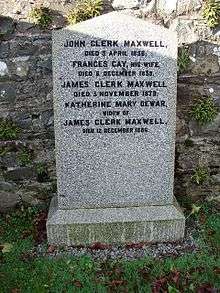Katherine Clerk Maxwell
| Katherine Mary Clerk Maxwell | |
|---|---|
 | |
| Born |
Katherine Mary Dewar 1824 Glasgow |
| Died | 12th December 1886 |
| Resting place | Parton, Dumfries and Galloway |
| Residence | Aberdeen and London |
| Citizenship | British |
| Fields | Physical Sciences |
| Influenced | James Clerk Maxwell |
| Spouse | James Clerk Maxwell |
| Children | 0 |
Katherine Clerk Maxwell (née Dewar) 1824 - 12 December 1886, was a Scottish physical scientist best known for her observations which supported and contributed to the discoveries of her husband, James Clerk Maxwell. She was born Katherine Dewar in 1824 In Glasgow[1][2] and married Clerk Maxwell in 1859.[3][4] Her contributions are largely recorded in writings on her husband, partly due to a fire at the Maxwell family estate which destroyed many of the family papers.[1] Katherine had no children and died in 1886.
Early Life and Marriage
Katherine Mary Dewar was born in 1824 In Glasgow,[1][2] the daughter of Susan Place[1] and the Very Rev. Daniel Dewar,[5] Principal of Marischal College, Aberdeen.[3] Little of her early life appears to be recorded.

When she was in her early thirties Katherine met James Clerk Maxwell (7 years her junior) during his tenure as Professor of Natural Philosophy at Marischal College (1856-1860).[1] James announced their engagement in February 1858[6] and they were married in the parish of Old Machar, Aberdeen on 2 June 1859.[3][4] The couple never had any children.[7]
Scientific Contribution
Before and during their marriage Katherine aided James in his experiments on colour vision and gases.[1][6] Katherine's observations were valuable to James' scientific work. A comparison of different readings observed by Katherine and those by C. H. Cay, led James Clerk Maxwell to develop his theory of colour vision and to discover the (commonly occurring) blindness of the Foramen Centrale to blue light.
Katherine appears to have played a significant role in Clerk Maxwell's experimental research. In a letter to P.G. Tait, James Clerk Maxwell wrote about Katherine's contribution to measurements of gaseous viscosity associated with his paper "On the Dynamical Theory of Gases", saying that Katherine "did all the real work of the kinetic theory" and that she was now "...engaged in other researchers. When she is done I will let you know her answer to your enquiry [about experimental data]".[1][8]
A fire at Glenlair destroyed the majority of Maxwell's papers which has made it more difficult for historians to reconstruct further details of Katherine Clerk Maxwell's scientific contribution.[1]
Personal life
After the merger of Marishal College with Kings College to form the new University of Aberdeen in 1860, James Clerk Maxwell lost his position and the couple moved to London for five years whilst Katherine's husband took up the role of Natural Philosophy Chair at King's College. Katherine nursed her husband through smallpox in September 1860 at the Maxwell family estate, then through erysipelas following a riding incident in September 1865.[6]
The couple moved to the Maxwell estate, Glenlair, in around 1865, with James using this time to write up some of his key work.[6] In 1871 James Clerk Maxwell became Cambridge University's first Cavendish Professor of Experimental Physics.[4] During this time the couple lived in Cambridge but continued to spend summers in Glenlair.[2]
Katherine had a number of health issues[6] and suffered a prolonged illness in 1876, which her husband nursed her through.[9] Despite this, and Katherine's role in caring for her husband, Margaret Tait (wife of P. G. Tait) is said to have accused Katherine of derailing her husband's career because of her illness and James Clerk Maxwell's care for her.[1]

Katherine was widowed when James Clerk Maxwell died of stomach cancer on 5 November 1879.[6] On the day of his death James expressed concern for Katherine's health.[6] Very little is known about Katherine's life during the seven years between her husband's death and her own.[1]
Katherine died on 12 December 1886 and is buried, with her husband James Clerk Maxwell in Parton, Dumfries and Galloway.[10]
References
- 1 2 3 4 5 6 7 8 9 10 Lightman, Bernard (2004). The Dictionary of Nineteenth-Century British Scientists: Volume 3: K-Q. Bristol, UK: Thoemmes Continuum. pp. 1381–2. ISBN 1855069997.
- 1 2 3 Flood, Raymond; McCartney, Mark; Whitaker, Andrew (2014-01-09). James Clerk Maxwell: Perspectives on his Life and Work. OUP Oxford. ISBN 9780191641251.
- 1 2 3 O'Conner, John J.; Robertson, Edmund F. "James Clerk Maxwell (biography)". MacTutor History of Mathematics archive. School of Mathematics and Statistics University of St Andrews, Scotland. Retrieved 31 October 2016.
- 1 2 3 "Facts about James Clerk Maxwell". James Clerk Maxwell Foundation. James Clerk Maxwell Foundation. Retrieved 31 October 2016.
- ↑ Lundy, Darryl. "Katherine Mary Dewar". The Peerage. Retrieved 31 October 2016.
- 1 2 3 4 5 6 7 Campbell, Lewis; Garnett, William (2010-06-03). The Life of James Clerk Maxwell: With a Selection from His Correspondence and Occasional Writings and a Sketch of His Contributions to Science. Cambridge University Press. ISBN 9781108013703.
- ↑ "James Clerk Maxwell". Westminster Abbey: History (People). Retrieved 2016-10-31.
- ↑ Clerk Maxwell, James (1877). Letter to P.G. Tait. Maxwell Papers, Cambridge University Library.
my better 1/2, who did all the real work of the kinetic theory is at present engaged in other researches. When she is done I will let you know her answer to your enquiry [about experimental data]
- ↑ Everitt, C. W. F. (1975). James Clerk Maxwel: Physicist and Natural Philosopher. New York.
- ↑ "James Clerk Maxwell's burial place at Parton". www.clerkmaxwellfoundation.org. James Clerk Maxwell Foundation. Retrieved 2016-10-31.